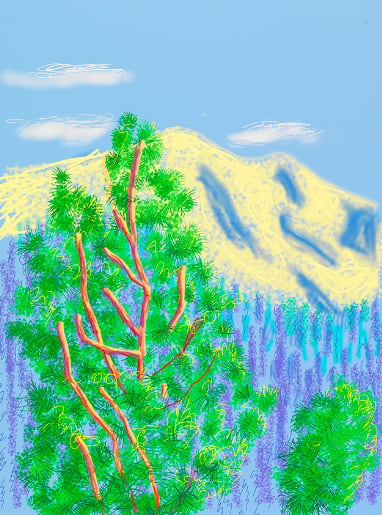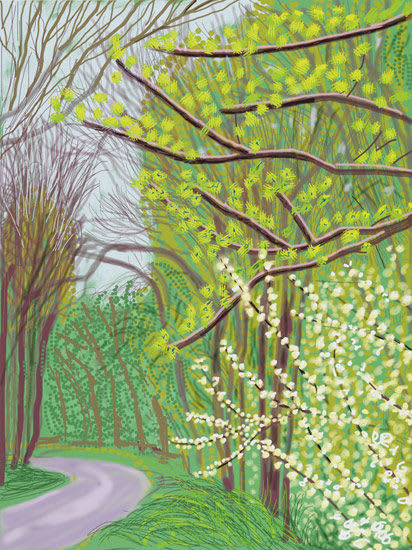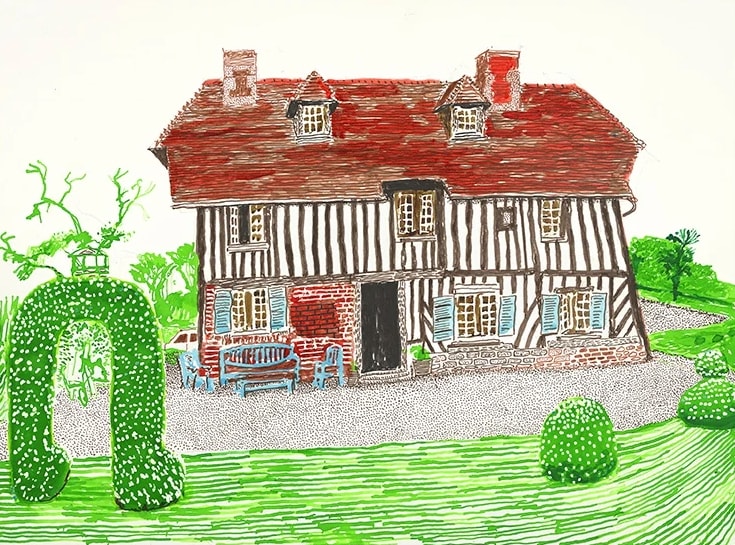David Hockney has long been captivated by the idea of place. From the sun-drenched swimming pools of Los Angeles to the winding roads of the Yorkshire countryside, his landscapes are more than depictions of scenery—they are reflections of experience, time, and presence. Nowhere is this more apparent than in three of his most distinctive series: *Yosemite Suite* (2010–2011), *The Arrival of Spring* (2011–2013), and the more recent iPad drawings created during his time in Normandy. Across these works, Hockney embraces the immediacy of digital drawing to deepen his exploration of how travel and rootedness shape our visual and emotional connection to place.
A Digital Turn: The Yosemite Suite
In 2010 and 2011, Hockney traveled to Yosemite National Park, a location steeped in the legacy of American landscape art. Rather than hauling paint and canvas into the wilderness, he brought along an iPad. The result was *The Yosemite Suite*, a collection of digitally drawn landscapes that capture the majesty of the park with striking intimacy and freshness. These works mark a significant moment in Hockney’s career—not only as a technical experiment but as a reimagining of plein air painting for the 21st century.
The Yosemite works are filled with vibrant colors, exaggerated forms, and dynamic perspectives. Hockney emphasizes the vertical grandeur of the forest by elongating tree trunks that stretch heavenward, while waterfalls cascade through swirling clouds in a style both spontaneous and carefully composed. The immediacy of the iPad allowed Hockney to draw from life directly in the field, capturing the fleeting interplay of light, mist, and movement without the delays or constraints of traditional media.
Travel to Yosemite inspired Hockney to consider how grand landscapes, often romanticized in art history, could be rendered with the playful directness of modern technology. The result is not a documentation of Yosemite as much as a felt experience—one that speaks to the artist’s enduring curiosity and reverence for the natural world.

The Arrival of Spring: A Return to Yorkshire
Just as travel had broadened Hockney’s horizons in the Yosemite series, his return to Yorkshire—the region of his childhood—brought a different kind of inspiration. Between 2011 and 2013, Hockney immersed himself in the landscapes of East Yorkshire, walking and driving the country roads, observing the slow, cyclical changes in nature. This period gave rise to *The Arrival of Spring*, a monumental body of work comprising iPad drawings and large-scale paintings.
In these works, the subject is not a single place but the passage of time as it unfolds in a familiar setting. Using his iPad, Hockney recorded the daily transformations of trees, hedgerows, and skies as winter receded and spring emerged. The digital format enabled him to work quickly and consistently, tracking subtle shifts in color, light, and atmosphere with an immediacy akin to a visual diary.
What sets *The Arrival of Spring* apart is its blend of modern technique and pastoral subject matter. Hockney embraces technology not as a novelty but as a tool that enhances his ability to observe, remember, and respond to his environment. The resulting images, often printed on large panels, echo the scale and spirit of historical landscape painting, while the digital origin gives them a unique luminescence and clarity.
This series speaks to the influence of home—not in a nostalgic sense, but as a deep engagement with place through familiarity and repetition. Yorkshire becomes more than a backdrop; it is a living, breathing presence that Hockney revisits with affection and precision.

Normandy: The Intimate View from Home
In 2019, Hockney moved to a 17th-century house in Normandy, France, seeking a quieter life and new visual inspiration. His time there coincided with the COVID-19 pandemic, during which travel restrictions and lockdowns forced many artists to turn inward. For Hockney, this period became one of intense focus and creativity, resulting in a wealth of iPad drawings that capture the garden, surrounding countryside, and the rhythms of rural life.
Unlike the grandeur of Yosemite or the seasonal drama of Yorkshire, the Normandy works are more intimate and meditative. From blooming trees to the shifting sky, Hockney’s Normandy iPad drawings reflect a slower, more reflective engagement with place—one shaped by routine, solitude, and immersion.
The iPad once again proves to be an ideal medium for Hockney. Its portability and flexibility allow him to work en plein air, to capture quick impressions, and to refine compositions with a painterly sensitivity. Many of these works were shared digitally or reproduced in books and exhibitions, underscoring the fluid relationship between digital creation and public presentation.
In Normandy, the notion of “home” becomes central—not just as a physical dwelling but as a site of sustained observation. These works are less about spectacle and more about attention: the kind of noticing that comes only through staying still, returning to the same view day after day, and finding novelty in the familiar.

The Convergence of Place and Practice
Across these three bodies of work, a clear pattern emerges. Whether wandering the vast wilderness of Yosemite, revisiting the rural lanes of Yorkshire, or settling into the rhythms of life in Normandy, Hockney’s art is deeply responsive to place. But it is not place alone that drives the work—it is the act of looking, of translating vision into form, and of engaging with the tools that best capture the essence of a moment.
The iPad, often seen as a symbol of modernity, becomes in Hockney’s hands a bridge between tradition and innovation. It allows him to work with the immediacy of drawing and the complexity of painting, to create both in solitude and on-site, and to share his work with a global audience in new ways. Rather than replacing older methods, digital tools expand his practice, enabling him to respond more fluidly to the landscapes he inhabits.
David Hockney’s *Yosemite Suite*, *The Arrival of Spring*, and Normandy iPad drawings chart a journey through geography, technology, and personal experience. Each series reveals a different facet of his relationship to place—whether as traveler, returning native, or rooted observer. In all cases, Hockney reaffirms that the landscape is not just a subject to be painted, but a space to be inhabited, understood, and reimagined.
In an age where digital and physical worlds often feel disconnected, Hockney shows us that art can bridge the two—not by choosing one over the other, but by inhabiting both fully. Whether through the towering trees of Yosemite, the flowering lanes of Yorkshire, or the tranquil garden in Normandy, his work reminds us that to see is to live more deeply—and that every place, when seen with care, becomes a world of its own.
Discover David Hockney prints for sale and contact our galleries via info@guyhepner.com. Looking to sell? We can help, find out how to sell Hockney prints with ease. Explore more Hockney content in Why is Hockney important? The 5 Most Popular Hockney works and Daivd Hockney iPad works

